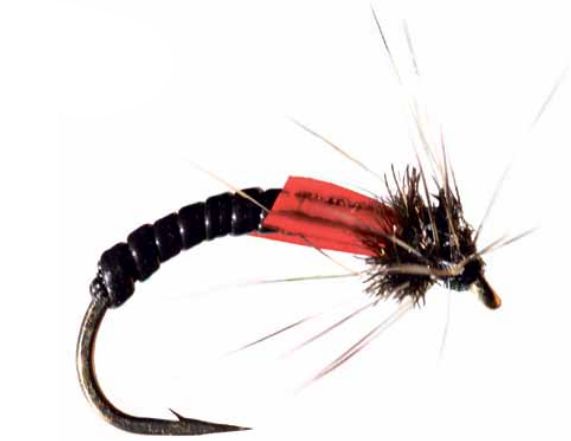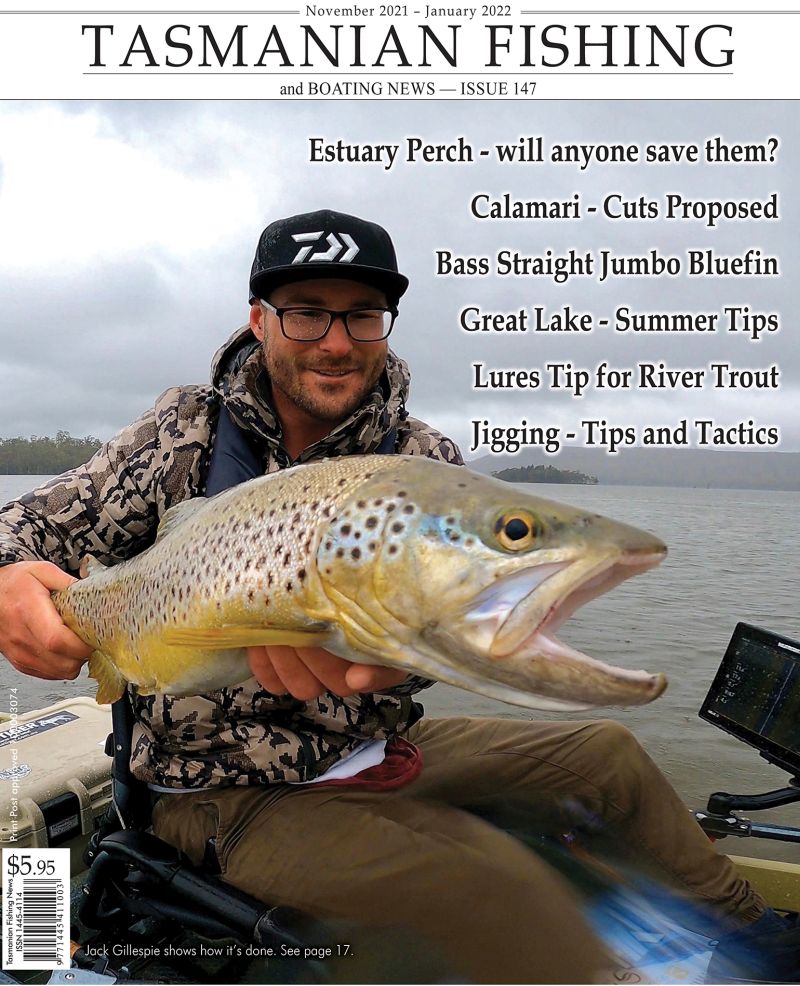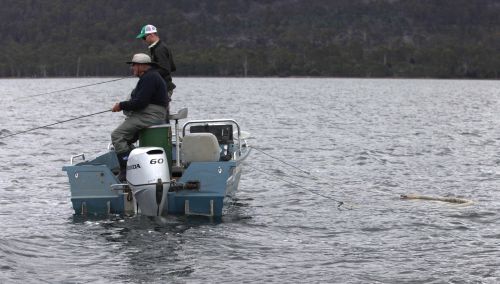From the Archives ...
"Angling is an art - Hannah Ledger
and an art worth your learning.."
Presented from Issue 112, October 2014
So said Izaak Walton in the 1600s. It seems that Burnie’s Hannah Ledger has combined angling with art rather well. Hannah is a fish fanatic, outdoor enthusiast and budding, self-taught artist. From as young as she can remember, she has always had crayon in hand, colouring book under arm and as she’s grown as a painter, jars full of paintbrushes and cupboards full of ready-to-go blank canvas’.
A country girl at heart, Hannah was schooled at Yolla District High School, a small ‘farm’ school in the states North West, then went on to Hellyer College where she was given the opportunity to really grow her art skills; And by grow, that meant skipping the classes that would probably have more an impact of getting her somewhere in life, like English and Math to spend every spare minute with the art teacher, painting or drawing.
As typical teenagers do, they make poor decisions- and after being accepted in to one of the countries top art schools, turned down the offer and decided to move to the big island, where she lived for 5 years working in what seemed ‘dead end’ retail.
Read more ...Please check all relevant authorities before fishing - www.ifs.tas.gov.au and dpipwe.tas.gov.au . Don't forget issuu.com/stevenspublishing for years of back issues !
Presented from Issue 95
Recent kayak popularity It was over 25 years, maybe 30 years ago, when I first saw someone fishing from water level in a boat. On a dark and windy night much to my amusement my mate John Rumph waddled into Lake Toolondo in the Grampians on a horrid night standing in what I think was the first ever float tube imported into Australia.
- Written by Stephen Smith - Rubicon Web and Technology Training
- Category: Kayak Fishing
- Hits: 6271
Presented from Issue 95
Huntsman Lake lies approximately 20 km south of Deloraine. It’s an easy, scenic drive via the small town of Meander. As most anglers know, the lake is only a few years old. It was formed in 2007 with the construction of the Meander Dam. The lake is fed by the Meander River and also by several small streams.
- Written by Stephen Smith - Rubicon Web and Technology Training
- Category: Kayak Fishing
- Hits: 10312
Presented from Issue 95
These days fishing techniques and fishing tackle just keep making more advances and becoming much more technical. I know I have fallen into that trap myself. I’ve just added a GPS to my arsenal, so that I can mark waypoints for hotspots. I also have a fish finder installed. Some kayakers even have high end fish finders with dual beam, side imaging, big colour screens and inbuilt GPS. The same kind of set up you’d see on a well laid out bream or trout boat.
- Written by Stephen Smith - Rubicon Web and Technology Training
- Category: Kayak Fishing
- Hits: 7835
Presented from Issue 95
The tip of dorsal fin momentarily cut the glassy surface of the lagoon followed by a slight swirl over the iseotes weed mound. This was the signal I had been waiting for, he was back. An accurate long cast placed the little Montana Nymph a few feet ahead of the slight ripple caused by this activity. This was met by a huge bow wave and swirl in the vicinity of the fly.
- Written by Stephen Smith - Rubicon Web and Technology Training
- Category: Trout Fishing
- Hits: 5938
 Presented from Issue 95
Presented from Issue 95
I do not want to sound all flowery and fluffy, but some of my recent fishing on Tasmania’s superb streams where the little birds flutter about at rod’s length and the caddis are like snowflakes hovering in the clouds all excites me. What must it do to the trout? There are, of course, many insects on these small streams, the main one at this time of year is the mayfly. But the eager trout are mostly happy to take almost anything you may present to them on the shallow bubbly waters. A little Red Tag size fourteen or a Deer Hair Caddis work well. Where the waters have some depth, my personal choice is a small wet, a nymph, beetle or stick caddis.
- Written by Stephen Smith - Rubicon Web and Technology Training
- Category: Jan’s Flies
- Hits: 4745
- Written by Stephen Smith - Rubicon Web and Technology Training
- Category: Western Lakes
- Hits: 9306
Presented from Issue 95
The Dorset River is a magic little stream that flows through Pera Flats at the foot of Mount Paris situated on the northeast corner of Tasmania near the town of Ringarooma. The “Dorset” is just one of the tributaries that flows into the very productive Ringarooma River. This small stream meanders its way down through a mix of farmland and native forest that generates all kinds of land based trout food which inevitably finds its way into the river for an opportunistic brown trout. When you add to this the ongoing aquatic lifecycles of a small stream and the competition for food amongst the fish that inhabit it, the trout become very willing to take a variety of well presented flies, lures or baits with this being one of the great attractions of fishing small streams such as this in Tasmania.
- Written by Stephen Smith - Rubicon Web and Technology Training
- Category: Other Rivers
- Hits: 6654
Presented from Issue 95
Over the last few years there has been many new frontiers that anglers have been faced with in the fishing world, there has been more changes to the way we fish, tackle we use and techniques we deploy than probably any other decade and as anglers we at times become enveloped in whatever new technique, lure or tackle happens to be the next big thing or “Revolution” in fishing. With information highways at our finger tips, social media everywhere we look, more fishing based television and media than ever before the amount of information available to the every day angler can be overwhelming and sometimes confusing.
- Written by Stephen Smith - Rubicon Web and Technology Training
- Category: St Helens
- Hits: 12000
Presented from Issue 95
Snap weight trolling was developed in North America for targeting suspended or structure hugging walleyes. To successfully target suspended or bottom hugging fish, no matter what species, requires a special presentation of your lure or bait. Downriggers are without doubt the best tool for precise presentations at depth, but can be a costly exercise if you are trolling in snag infested water, and you hang up your bomb on a submerged tree or rock. A snap weight line can easily be run in conjunction with a leadcore line, flat lines or downriggers. In addition, snap weight lines are perfect as planer board lines with either in line boards or double trolling boards, but let’s not worry about them here. The snap weight technique will prove a valuable asset for any dedicated troller as it will allow you to troll more deep lines without a downrigger or leadcore line. Places like Arthurs in deeper water, Great Lake, Dee Lagoon, Barrington and all the West coast waters are ideal for this technique.
- Written by Stephen Smith - Rubicon Web and Technology Training
- Category: Tackle, Boats and other Equipment
- Hits: 62156
Read more: Trolling techniques - Getting down with Snap Weights
Presented from Issue 95
I am lucky enough at the moment to be working a two weeks on, one week off roster. When I switched over to this roster I decided it was time for some midweek trips to places I have not fished a lot in the last few years.
A couple of years back whilst involved in the making of the fly fishing movie The Source Tasmania I had the opportunity to meet some champion blokes. Chris Reygaert flew over from Western Australia to help his brother, film maker Nick and he stayed at my house for a week or so. He ended up moving back to Tasmania to live a short time later, and we have become good mates. I love nothing more than spending a day on the water with Chris. He is a very accomplished fly angler and has a brilliant eye for a great photo, which is something I am becoming more passionate about with every fishing trip.
- Written by Stephen Smith - Rubicon Web and Technology Training
- Category: Trout Fishing
- Hits: 4675
Subcategories
Current TFBN
Click above for current issue content. The current issue of TFBN is extensive and topical. In Tackle Stores, Newsagents and by subscription.
Delivered to your door for $48 for 2 years (8 issues). To subscribe, send Mike $48 via www.paypal.com.au . (Basic instructions are here) The email is at Contact Us. Your address will be included from PayPal.
Or phone Mike with your c/c handy on 0418129949
Please ensure your details are correct, for Mike to organise delivery.
TFBN Newsletter Sign up Form
Why not submit an article ?
When you have finished for the day, why not have a brag about the ones that didn't get away! Send Mike an article on your fishing (Click here for contact details), and we'll get it published here. Have fun fishing - tasfish.com
Category Descriptions
Here is a list of all of the Article Categories. The number in Brackets, eg (13) is the number of articles. Click on Derwent River and all articles relating to the Derwent will be displayed in the central area.
Articles by Category
-
Rivers (3)
-
Saltwater and Estuary Fishing (149)
-
Kayak Fishing (34)
-
Lakes (1)
-
Great Lake (62)
-
Lake Leake (52)
-
Woods Lake (16)
-
Lake Augusta (11)
-
Huntsman Lake (13)
-
Lake Pedder and Gordon (10)
-
Lake Dulverton (5)
-
Lake Crescent (6)
-
Tooms Lake (10)
-
Lake Mackintosh (2)
-
Lake Barrington (5)
-
Little Lake (8)
-
Meadowbank Lake (5)
-
Lake King William (7)
-
Lake St Clair (2)
-
Western Lakes (12)
-
Arthurs Lake (35)
-
Lake Echo (7)
-
Four Springs (54)
-
Lake Sorell (7)
-
Lake Burbury (6)
-
Other Lakes (57)
-
Brushy Lagoon (18)
-
Little Pine Lagoon (5)
-
Penstock Lagoon (16)
-
Brumbys Creek (7)
-
-
Events (48)
-
Estuary Fishing (0)
-
Coastal Catches (46)
-
Super Trawler (46)
-
IFS, DPIPWE, MAST and Peak Bodies (435)
-
Commercial Interests (98)
-
Other (24)
-
TFBN Back Issues (8)
-
Fly Fishing (67)
-
Trout Fishing (252)
-
Meteorology and Weather (8)
-
Jan’s Flies (50)
-
Tuna Fishing and other Game Fishing (86)
-
Cooking Fish (19)
-
Fishing Information (1)
-
Fishing Books (8)
-
Videos (5)
-
Tackle, Boats and other Equipment (146)
-
World Fly Fishing Championship 2019 (2)
Popular Tags
windyty.com
Visit https://www.windyty.com/
Rubicon Web and Technology Training
Hello everyone, I thought it would be a good time to introduce myself.
My name is Stephen Smith and I have been managing the website tasfish.com since May 2009.
It has been an epic journey of learning and discovery and I am indebted to Mike Stevens for his help, support and patience.
I am developing a new venture Rubicon Web and Technology Training ( www.rwtt.com.au ). The focus is two part, to develop websites for individuals and small business and to train people to effectively use technology in their everyday lives.
Please contact me via www.rwtt.com.au/contact-me/ for further information - Stephen Smith.
From the Archives ... (last chance)
Sea runners - Early Season Excitement - Christopher Bassano
Presented from Issue 100
Considering the world class quality of our sea trout fishery, these fish are not sought after by enough anglers. Sea runners live in the salt water and run up our estuaries and rivers from the start of August to the middle of November. At this time of the year, they are here to eat the many species of fish that are either running up the rivers to spawn or are living in and around the estuary systems. Trout, both sea run and resident (Slob Trout) feed heavily on these small fish which darken in colouration as they move further into fresh water reaches.
The majority of these predatory fish are brown trout with rainbows making up a very small percentage of the catch. They can be found all around the state but it would be fair to say that the east coast is the least prolific of all the areas. They still run up such rivers as the Georges (and many others) but their numbers along with the quality of the fishing elsewhere make it difficult to recommend the area above the larger northern, southern and western rivers.
Read more ...


